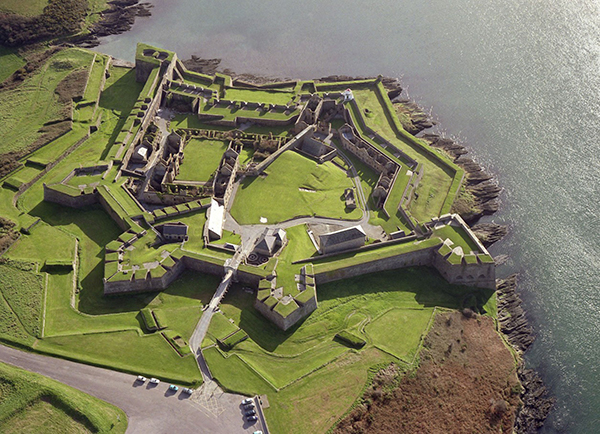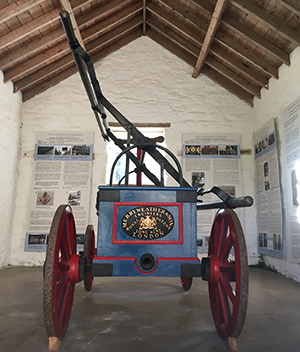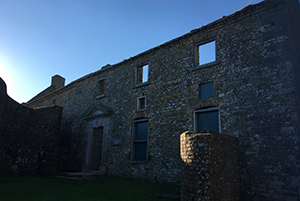CHARLES FORT
Published in Issue 1 (January/February 2022), Reviews, Volume 30Kinsale, Co. Cork
(021) 477 2263
charlesfort@opw.ie
By Tony Canavan
On a recent break in Kinsale, I took the opportunity to visit Charles Fort, which, along with the smaller James Fort, guards the entrance to the harbour of this historic town. From the outside the fort is impressive, but only once inside do you realise just how big it is. The many buildings, occupying 5ha, constitute a village, and you can well believe that it once housed an average of 440 soldiers and their families.

Above: The classic star-shaped military fortress, occupying 5ha, was constructed between 1677 and 1682, during the reign of King Charles II.
The classic star-shaped military fortress was constructed between 1677 and 1682, during the reign of King Charles II. Kinsale had already been used for a foreign invasion when a Spanish force landed there in 1601 to assist Hugh O’Neill in his war against Queen Elizabeth, and the British were determined that it would not be so used again. William Robinson, architect of the Royal Hospital, Kilmainham, and superintendent of fortifications, designed it. It is one of the largest in the country and is associated with some of the most momentous events in Irish history, from the Williamite War in 1690 to the Irish Civil War. Charles Fort only saw combat once, however, when in 1690 it was attacked by the army of William of Orange, who ousted the Jacobite garrison after a thirteen-day siege. It was garrisoned by the Essex Regiment during the War of Independence and was subsequently burned by anti-Treaty forces in 1922, when the fort was abandoned. The most unusual episode before 1973, when it became a National Monument under the care of the Office of Public Works, was when a hippy colony was set up there in the 1960s.

Above: The exhibition space is dominated by a hand-operated fire pump.
Guided tours in different languages can be arranged and there are guidebooks in English, Irish, French, German, Italian, Spanish, Polish and Dutch. My friend and I did a self-guided tour with the aid of an information sheet, which has a useful map of the fort with a potted history on the back. Besides this, there are a number of attendants around the complex who are happy to answer any questions. Your tour takes you around the walls of the fort with its bastions, including the colourfully named Cockpit Bastion and Devil’s Bastion. These walls are 12m wide and at one time had 94 cannons mounted on them. Looking over the walls, you will not only see great views but also get an idea of how difficult it would be to attack the fort, with its supplementary defences and ramps.
Inside, many of the buildings date from the Georgian era, with others added in the nineteenth century. There were barracks for infantry and artillery, quarters for the officers’ and soldiers’ families, stores for ammunition and other supplies, messes where the soldiers were fed, and a hospital for the sick. At its height, the fort was a scene of constant activity, as the soldiers were given tasks to perform, drills to carry out and instructions on the parade ground. The fort had a vocabulary of its own, with such terms as ‘glacis’, ‘counterscarp’ and ‘sally-port’, but don’t worry, these are all explained.
While most of the buildings are simply shells, there are many relics of its military era about the fort, such as cannons from different centuries. One building has been restored as a tearoom and another houses an exhibition on the history of the garrison. This is dominated by a hand-operated fire pump, and around the walls are information panels and photographs relating to the various regiments associated with the fort, such as the Munster Fusiliers and the Connaught Rangers. There is also a roll of honour of men from Charles Fort who were killed in the First World War.

Above: The Governor’s House, which is squeezed between a barracks and a blast wall.
(All images: Charles Fort/OPW)
It is fascinating to wander through all the buildings. You get a sense of history coming to life, as turning every corner reveals something new. I was struck by how many of the buildings were constructed in confined areas, leaving little or no space between them and the walls of older buildings. One example is the Governor’s House, which is squeezed between a barracks and a blast wall. The guides add an extra dimension to the tour, as they explain just what the different things are and provide some of the history. My companion and I had a fascinating conversation with one of the guides about the impact that the garrison had on the town, bringing not only much-needed income into the local economy but also a level of riot and public disorder not experienced by non-garrison towns.
At the time of my visit there were still Covid-19 restrictions in terms of social distancing and the direction of the tour, but they did not impinge on the experience. Visitors are advised, however, to wear suitable footwear owing to the uneven terrain, and children must be accompanied at all times. Fortifications like this do not loom large in our perception of Ireland’s past but Charles Fort was certainly significant and is well worth a visit.
Tony Canavan is Consultant Editor of Books Ireland.
















